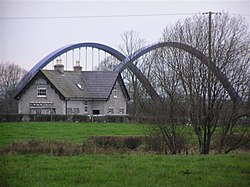Toome: Difference between revisions
Created page with "{{Infobox town |name=Toome |county=Antrim |picture=Toome Bridge - geograph.org.uk - 634347.jpg |picture caption=The bridge over the River Bann at Toome |os grid ref=H9990 |lat..." |
|||
| Line 34: | Line 34: | ||
==Outside links== | ==Outside links== | ||
{{commons}} | |||
*[http://www.riverbannireland.com/Toome.T294.aspx River Bann] - Toome visitor information | *[http://www.riverbannireland.com/Toome.T294.aspx River Bann] - Toome visitor information | ||
*[http://www.bbc.co.uk/ni/landscapes Landscapes Unlocked] | *[http://www.bbc.co.uk/ni/landscapes Landscapes Unlocked] | ||
Latest revision as of 20:30, 5 September 2014
| Toome | |
| County Antrim | |
|---|---|
 The bridge over the River Bann at Toome | |
| Location | |
| Grid reference: | H9990 |
| Location: | 54°45’0"N, 6°27’36"W |
| Data | |
| Population: | 722 (2001) |
| Post town: | Antrim |
| Postcode: | BT41 |
| Dialling code: | 028 |
| Local Government | |
| Council: | Antrim and Newtownabbey |
| Parliamentary constituency: |
South Antrim |
Toome or Toomebridge is a small village and townland on the northwest corner of Lough Neagh in County Antrim, on the River Bann, which forms the border with County Londonderry. In the 2001 it had a recorded population of 722. The village also gives a name to two baronies of County Antrim: Toome Upper (in which the village lies) and Toome Lower.
History
Roddy McCorley, a Presbyterian radical, was a local of the parish of Duneane. He fought as a United Irishmen in the Rebellion of 1798 against the Ascendancy's rule in Ireland but was captured. He was executed on 28 February 1800, "near the bridge of Toome", which had been partially destroyed by rebels in 1798 to prevent the arrival of reinforcements from west of the River Bann. His body was then dissected by the British forces and buried under the road that went from Belfast to Londonderry. In 1852, when the road was being reconstructed, a nephew had McCorley's body exhumed and given a proper burial in an unmarked grave in Duneane. A memorial in honour of McCorley now stands in Toome as you enter the village from County Londonderry. His story became the subject of a popular song written in 1898 by Ethna Carbery.
Economy
- The largest industry in Toome is eel fishing, supplying the European market. The eels spawn in Lough Neagh (after their long swim from the Sargasso Sea and up the Bann to the Lough) and fisheries are maintained on the Bann here. The eel fisheries have been commemorated in a number of poems by Seamus Heaney.
- Within the last century mining for diatomite has developed as extensive deposits of diatomite are found in the Toome area. This mineral was used as an absorbent for gelignite and for toothpaste.
- The expanding Toome Business Park has been helping the economy of the village for over the past ten years.
Sport
- Gaelic Athletics: Erin's Own, Cargin
Transport
- Toome had long been a bottleneck to traffic on the main Belfast to Londonderry road route. Construction of a bypass began in May 2002 and was completed in March 2004, shortening journey times and relieving congestion in the village.
- Toome railway station was opened on 10 November 1856, shut for passenger traffic on 28 August 1950 and shut altogether on 1 October 1959.[1]
Outside links
| ("Wikimedia Commons" has material about Toome) |
- River Bann - Toome visitor information
- Landscapes Unlocked
References
- ↑ "Toome station". Railscot - Irish Railways. http://www.railscot.co.uk/Ireland/Irish_railways.pdf. Retrieved 2007-11-24.
